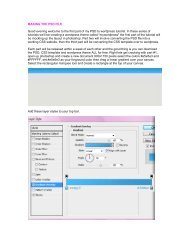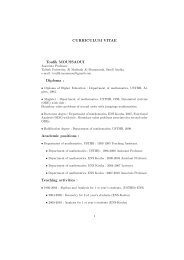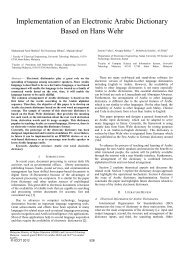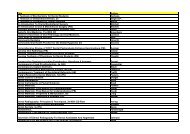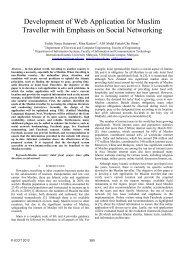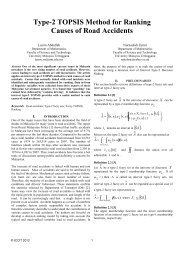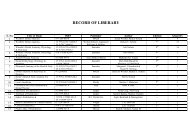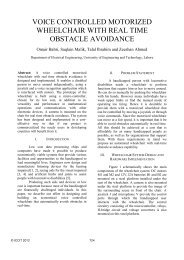Protocol Design and Implementation of Vehicular Ad-hoc Networks
Protocol Design and Implementation of Vehicular Ad-hoc Networks
Protocol Design and Implementation of Vehicular Ad-hoc Networks
You also want an ePaper? Increase the reach of your titles
YUMPU automatically turns print PDFs into web optimized ePapers that Google loves.
module, a 2 byte value is also received though it<br />
may not be used in some cases.<br />
When the system is first powered up, a<br />
function is called which initializes the RMF12<br />
module by giving it a number <strong>of</strong> comm<strong>and</strong>s to<br />
bring it to the desired settings <strong>and</strong> enabling all<br />
required features. To transmit a byte <strong>of</strong> data, the<br />
FM module is given the comm<strong>and</strong> “B8XXH”<br />
where XX is the byte to be transmitted. Before<br />
transmitting our data payload, we must first<br />
transmit the preamble “AAAAAAH” followed by<br />
the synchronization bit sequence “2DD4H” [8].<br />
When the module receives a byte <strong>of</strong> data, it stores<br />
it in its receiver FIFO register. To read this<br />
register, the module is given the comm<strong>and</strong><br />
B000H. The data will be in the lower byte <strong>of</strong> the<br />
two byte data received. The received data must be<br />
read immediately after receiving; otherwise the<br />
register will be overwritten if more data is<br />
received.<br />
B. <strong>Protocol</strong> Details<br />
The RFM12 module is only capable <strong>of</strong><br />
performing one function at a time; that is, it is<br />
unable to transmit <strong>and</strong> receive at the same time.<br />
Thus, it is only put into transmitting mode when<br />
some data is to be sent, <strong>and</strong> then shifted back to<br />
receiving or listening mode. Another point <strong>of</strong><br />
importance is the switching <strong>of</strong> the module<br />
between channels. With channel 1 at 433MHz <strong>and</strong><br />
channel 2 at 439.75MHz, The FM transceiver is<br />
tuned to listen at the channel where the next frame<br />
is expected to arrive.<br />
The Broadcasting Unit <strong>of</strong> the Roadside<br />
Module is programmed to transmit a DR frame<br />
followed by 49 SB frames with delays <strong>of</strong> 100ms<br />
between them <strong>and</strong> the cycle is repeated<br />
continuously. This results in a DR frame being<br />
transmitted once every 5 seconds, <strong>and</strong> at this<br />
moment, the BU triggers an interrupt on the<br />
Responding Unit. The RU then opens up the<br />
UART connection between it <strong>and</strong> the<br />
Broadcasting Unit <strong>and</strong> the BU obtains the vehicle<br />
count in the region from the RU over the<br />
connection. The BU then uses this updated value<br />
in the DR <strong>and</strong> SB frames it is broadcasting. The<br />
BU does not expect to receive anything so it<br />
remains in the transmitting mode. Also, all the<br />
frames it transmits are in ch1.<br />
It is the job <strong>of</strong> the Responding Unit <strong>of</strong> the<br />
Roadside Module to wait for vehicles to contact it,<br />
<strong>and</strong> when they do, to acknowledge their<br />
transmission. The RU keeps a one byte global<br />
722<br />
variable rx_frame which is initially initialized to<br />
zero. When the FM transceiver receives data, the<br />
nIRQ pin <strong>of</strong> the module goes low <strong>and</strong> this triggers<br />
an interrupt on the microcontroller. The Interrupt<br />
service routine calls a function which stores the<br />
received frame in the rx_frame variable. The RU<br />
only expects to receive frames in channel2.<br />
Therefore, it initially tunes to ch2 in the receiving<br />
mode <strong>and</strong> waits, continuously polling the valid bit<br />
<strong>of</strong> rx_frame. The valid bit going high indicates a<br />
frame being received, <strong>and</strong> the RU saves the<br />
required data from the frame before clearing it to<br />
make it ready for the next received frame. If the<br />
received frame is a VR frame, the RU will enter<br />
the transmission mode briefly to transmit the ACK<br />
frame (in ch2) <strong>and</strong> enter the vID <strong>of</strong> the vehicle in<br />
the array v_list. This array contains entries <strong>of</strong><br />
vehicles registered to the station. The RU will also<br />
trigger an interrupt on the BU signalling it to<br />
listen to the UART connection opened by the RU,<br />
over which the RU will send the updated vehicle<br />
count to the BU. It may be possible that the<br />
vehicle may not receive an ACK for some reason,<br />
in which case it will transmit the VR frame. The<br />
RU must detect <strong>and</strong> ignore duplicate VR frames.<br />
The RU treats E frames in a similar manner. It<br />
maintains an emergency list where it keeps<br />
records <strong>of</strong> vehicles facing an emergency. Each<br />
entry is valid only for 30s after which it is<br />
removed.<br />
The <strong>Vehicular</strong> Module is undoubtedly the<br />
most complex <strong>of</strong> the three. It must listen at both<br />
the channels for specific frames as well as<br />
properly h<strong>and</strong>le <strong>and</strong> forward Emergency frames.<br />
The VM initially listens at ch1 for the SB, DR or<br />
E frame <strong>and</strong> remains in this state for the majority<br />
<strong>of</strong> the time. To transmit the VR frame, the VM<br />
switches to ch2. It then starts a timer <strong>and</strong> waits for<br />
the ACK frame. If it is received before the timer<br />
overflows, the VM saves the sID <strong>of</strong> the station. As<br />
soon as an ACK is received, or the timer<br />
overflows, the VM will switch back to ch1 <strong>and</strong><br />
continue listening. If the vehicle receives an E<br />
frame, <strong>and</strong> the frame is found not to be a<br />
duplicate, the VM will enter the vID <strong>of</strong> the<br />
received frame in its emergency list. It will then<br />
check the TTL value <strong>of</strong> the frame, <strong>and</strong> if it is zero,<br />
it will take no further action. If the TTL value is<br />
non-zero, the VM will decrement it <strong>and</strong> transmit<br />
the modified E frame in ch1 where it will be<br />
received by other nearby vehicles <strong>and</strong><br />
retransmitted. If a vehicle has an accident it will



